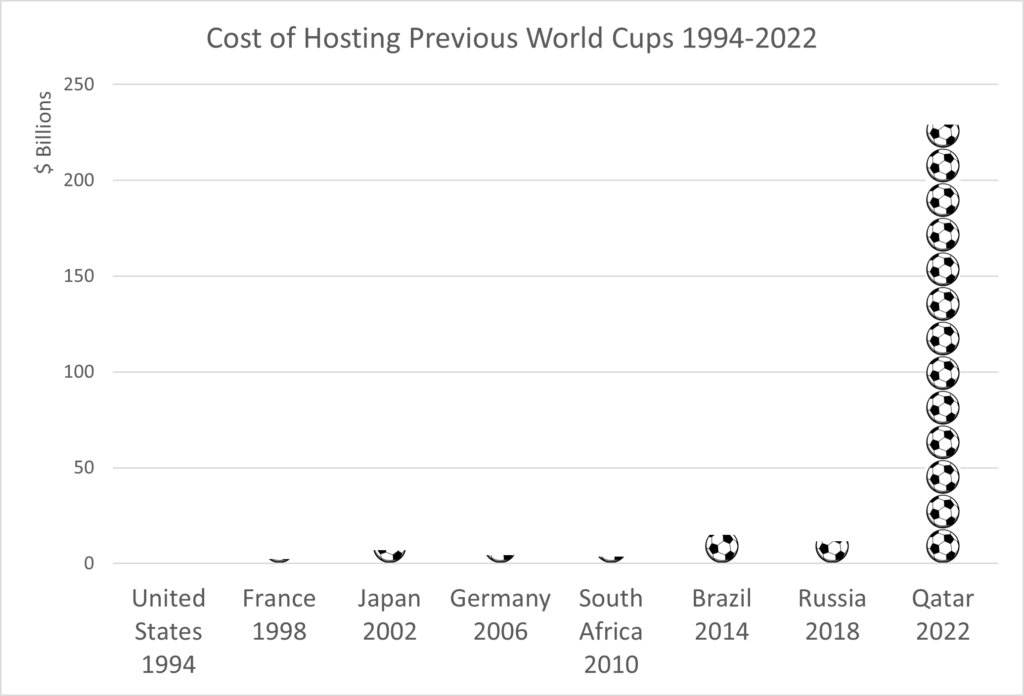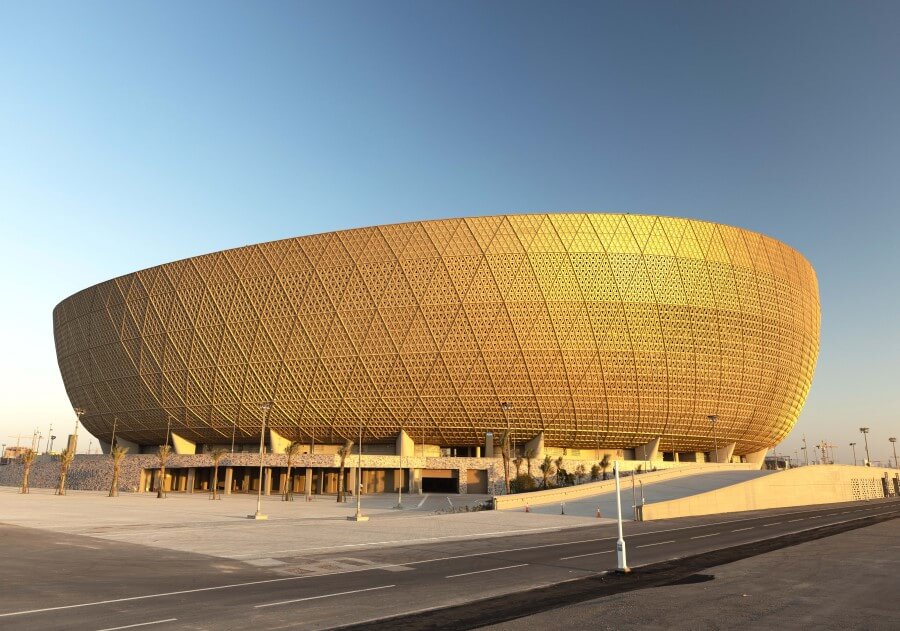With the Qatar World Cup just underway, Matt Lyons takes a look at the costs of the megaevent for Qatar, and what the potential benefits might be for the host country.
The Qatar World Cup kicked off (sorry) yesterday and an estimated 1.2 million visitors will visit the first Middle East nation to host the tournament. While sitting in the air-conditioned stands in shiny new stadiums surrounded by newly constructed towers and roads one question is bound to be on the minds of many – how much did all this cost?
The Qatar World Cup is widely reported to cost $229 billion (£138 billion) to put this into context see the below list of the last seven World Cups:

The figure is so large it is hard to comprehend – for more context the Qatar World Cup is estimated to cost over 15 times the cost of the London Olympics (£8.7 billion).
However, the cost is just one side of the balance sheet. What is the benefit of the Qatar World Cup?
Measuring the Impact of Megaevents
Measuring the economic and social impact of hosting a megaevent is a lively field of study with the academic literature often pouring cold water on the economic impacts estimated in impact studies.
The reality of assessing the wider legacy of megaevents is understandably a difficult task with a portfolio of ‘soft’ impacts to be considered:
Health:
Hosting sporting events are often linked to increased physical activity for the local population for example which can lead to increased productivity and reduced healthcare costs. Linked to physical health is the issue of mental health and well-being that may benefit as a result (though these impacts are often small).
Community:
The construction of accommodation and infrastructure for megaevents is often an opportunity to revitalise or in some cases birth new communities. Volunteers often play a critical role in supporting megaevents and there is some evidence that this can lead to a more engaged volunteer pool to draw on in the future for other purposes.
Reputation:
A further important consideration is the reputational effects hosting megaevents can have on the brand of the city/nation in question.
Once captured how can we be sure these are directly linked to the megaevent which may have been 2, 5 or 10 years passed?
The Impact of the Qatar World Cup
While the difficulties with these kinds of studies are clear there this blog will consider three economic impacts typologies that the upcoming Qatar World Cup will see.
Before – The Construction Phase
Traditionally in the run-up to a megaevent, the construction phase is an opportunity to upskill the local workforce and deliver jobs for the local population before the event has even started.
Qatar had a bumper construction period with an estimated £31 billion spent on transport infrastructure including an expressway, a new metro system, electric buses and scooters. £107 billion on building seven new 40-80,000 spectator capacity stadiums, £48 billion on about 100 new hotels and facilities for athletes. Finally, £28 billion has been spent on the construction of a new city, Lusail.
Hosting a megaevent like the World Cup is often sold to those footing the bill as an investment in the future with benefits arising from new facilities for example. This can be successful, after the 2012 London Olympics, a ComRes poll for the BBC suggested over two-thirds of the British public believed the cost of the games was worth it. This can be unsuccessful, with many cities abandoning their newly constructed stadiums shortly after the event is over. There is a danger that these mistakes are being repeated in Qatar. Qatar is also not a major footballing nation and has a population smaller than that of Wales, estimated at 2.9 million. Whether Qatar will be able to succeed where others have failed to recycle or repurpose its 8 stadiums remains to be seen.
There is no doubt this huge injection of cash into infrastructure will have some benefit to the local economy, however, whether it will outweigh the cost is one for the impact studies to come.

During – The Impact of Tourism
Tourism impact assessment is a common feature of megaevent analysis with visitors filling hotels, hospitality and cultural venues tills with cash. In a recent blog, we conducted an early assessment of the tourism impact of the 2022 Birmingham Commonwealth Games.
The Qatar World Cup is estimated to have 1.2 million visitors and with other tourism projects in the pipeline, Qatar expects to see a boost to its annual tourism in the long term with 6 million tourists visiting annually by 2030.
Whilst 1.2 million might seem like a large number, but how does that compare with previous World Cups? The 2018 World Cup in Brazil had an estimated 3.5 million visitors, so, on this second impact typology, the impact might be considered underwhelming.
Legacy – Reputational Impacts
FIFA president Gianni Infantino estimates 5 billion spectators will watch the Qatar World Cup, making it clear that Qatar has the world’s attention. Typically, this is good news for the hosting country, a chance to show on the world stage their ability to host a successful event which will encourage future investment in the country and increased tourist activity.
However, Qatar has seen a deluge of bad press that is sure to damage its reputation. The bad press started almost immediately with allegations of corruption around the World Cup bid itself (now the subject of a Netflix documentary). In the years that followed there have been worrying reports on the human cost of the construction of the stadiums. More recently, the issue of LGBTQ rights and safety has been drawn into focus with MP Luke Pollard saying “It is not safe for someone like me to watch the world cup in Qatar”.
Additionally, the construction of the world’s longest air-conditioned running track as well as outdoor air-conditioned stadiums designed to keep the imported American grass seed pitches cool has drawn criticism especially given Qatar’s claims of being “the first carbon-neutral world cup”.
The impact these factors have had on the reputation of Qatar can be seen in the calls to boycott the World Cup. One YouGov poll found 7 in 10 Brits support a boycott of the tournament. A sentiment reflected across other countries in Europe and the USA. This negative view, however, is not held by all. Criticism from Western nations has led other nations, particularly in the Middle East to show solidarity with Qatar.
Therefore, on this third impact typology, Qatar may be set to receive a negative reputational effect in what academic Dr Paul Brannagan and colleagues at Manchester Metropolitan Universities have termed ‘soft disempowerment’.

Conclusion
To take a nuanced look at the legacy of a megaevent is always challenging. At face value, the Qatar World Cup is the most expensive World Cup ever hosted. But the context is important, the spending is part of Qatar’s national plan which aims to diversify the economy away from hydrocarbons and towards services and tourism.
Beyond the economics, hosting the World Cup will likely change Qatar. There have already been significant changes to labour law with exit system reform and the introduction of a minimum wage. These are key examples that may not have come to pass without the international attention the tournament has brought. The impact of 1.2 foreign visitors to the small country over the next few weeks might lead to further changes we cannot yet predict.
This blog was written by Dr Matt Lyons, Research Fellow, City-REDI / WMREDI, University of Birmingham.
Disclaimer:
The views expressed in this analysis post are those of the authors and not necessarily those of City-REDI / WM REDI or the University of Birmingham.

